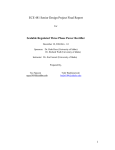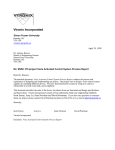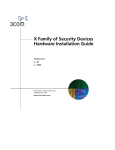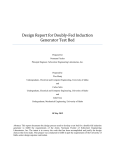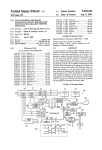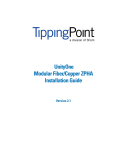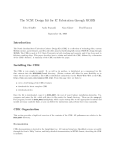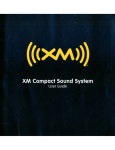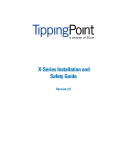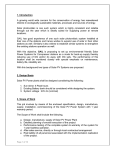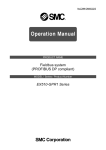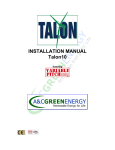Download cwt 300 wind turbine control system manual
Transcript
r=>: I ~. ( c· ';, CWT 300 WIND TURBINE CONTROL SYSTEM MANUAL October 27, 1993 CARTER WIND TURBINES, INe. 1900 FM 369 SOUTH .~ BURKBURNETT, TX 76354 (817)569-3339 AN INTRODUCTION TO THE CWT 300 WIND TURBINE In order to become familiar with the Carter Wind Turbines Model 300, one must first understand the basic systems of the turbine. This preface is a general overview of systems such as the normal start up and shutdown sequence, overload/overspeed protection, and yaw operation (wind tracking). The Model 300 does not motor up to operating speed nor does it brake to a stop when the unit stops generating due to a decrease in wind velocity. The blades continue to turn even if there is not enough wind to drive the blades at generating rpm. At a wind velocity of approximately 8 mph, however, there is enough energy in the wind to bring the blades up to generating rpm. Each Model 300 wind turbine has an Enerpro SCR (silicon controller rectifier) controller which can turn the generator on and off 120 times per second and can in effect vary the generator voltage like a light dimmer switch. This controller constantly monitors the generator rpm. Once the generator has reached approximately 1800 rpm (1500 rpm for UK version) with blade rotor rpm of 65 for both US and UK, the main controller signals the SCR controller to come on, thus tying the generator into the utility grid. If the rpm is less than 1800 (1500 UK) and accelerating, the controller also monitors the acceleration rate and, depending upon how fast the generator is accelerating, decides at which voltage level the generator should come on and anticipates when the SCR's should be signaled to close so that current is flowing when the generator reaches precisely 1800 rpm (1500 UK). The variable voltage system can be used to run the generator at the most efficient voltage corresponding to the generator's KW output. This feature can significantly improve the wind generator's yearly KWhr production, providing the most improvement when the generator output is less than 50 KW. For example, at a 5 KW output the generator efficiency is 83 % when using the variable voltage controller but is less than 30% when run at 480 volts (no variable voltage control). Even though the generator's voltage is effectively varied, the voltage output to the utility grid is held constant. At over 80 KW, however, the generator voltage is not varied. As the wind velocity decreases, the voltage level on the generator is reduced to the lowest level, then as the generator rpm drops below 1800 (1500 UK) and it stops producing positive power, the controller signals the SCR's to stay open, thus taking the generator off line. As long as the generator is tied into the utility grid and generating, the blades do not change pitch relative to the blade plane of rotation, regardless of the wind speed. A pitch change will only occur if there is a power outage or if the controller senses an error. Although the blade pitch stays constant relative to the blade plane of rotation while the unit is generating, the angle of attack of the resultant wind into the blade does change as the wind velocity changes. This change in angle of attack with changing wind velocities only works if the rotor rpm stays relatively constant. The wind vector due to the velocity of the blade rotation stays constant, so as the wind vector due to the wind velocity changes, the resultant velocity vector of both the rotational vector and wind vector changes both velocity and angle of attack of the air flow into the blades and thus changes power output. By using a correct combination of blade shape, blade TECHDATA\INTR0300.CWT REVISION -1-. 5/93 -1- twist, airfoil selection, blade rotor rpm and generator size, the unit will automatically regulate maximum output so as not to overload the generator regardless of the wind velocity. As a result, the units can generate in winds in excess of 50 mph without overload. This feature is accomplished without any mechanical pitch changes, servo systems, or monitors that check generator load, rpm, or temperature, and results in a very simple, reliable, inherent overload protection. A fail-safe, mechanical overspeed control method is used to protect the unit from an overspeed condition that would occur if the generator was disconnected from the utility grid by a power outage or by the controller sensing an error and turning off the SCR's. While the unit is generating, the fixed utility frequency and major load source keeps the generator rpm constant and keeps the system from going into overspeed. However, all the time the blade rotor is turning, the blades are trying to pitch up as a result of centrifugal forces acting on the inboard cuff of each blade as well as the leading edge arm weights. The blades are kept from pitching up by a very strong electromagnet inside each blade. If power is removed from the electromagnet for any reason (such as a power outage or the controller sensing an error), then the blades can immediately pitch up causing the blades to go into a deep stall. In this deep stall the lift drops off and the drag increases to the point that the blades will no longer freely turn and are aerodynamically braked to a stop. The higher the winds, the deeper the stall, thus the blades actually come to a stop faster in higher winds. Once power is removed and the blades start pitching up, the rotor rpm starts to increase at the same time. Not until the blades have pitched up and the blade angle of attack relative to the air flow is approximately 12 degrees is there a balance between the driving force to accelerate the rotor and the drag to slow down the rotor. The blades can move 21 degrees before the "pitch up stops stop the pitch up travel. At this point the drag is much greater than the driving force and so the blade rotor slows down and comes to a stop. The maximum torque on the rotor blades and hence the point at which the blades would accelerate the fastest occurs at a wind velocity between 50 and 60 mph. Above 60 mph the blades are in a deeper stall and thus generator output is reduced. Because it takes a certain amount of time for the blades to pitch past 12 degrees, it is at this wind speed (50 - 60 mph) that the rotor sees its maximum overspeed rpm. Maximum overspeed rpm can reach one and one-half times normal generating rpm, although in the research and development stages the rotor rpm did exceed two and one half times normal. Because the CWT blades are relatively lightweight and very efficient, the blade rotor rpm could double in less than' two seconds, hence the need for an extremely fast acting blade pitch change mechanism. Since there are no servo systems in the Carter design, the blades can pitch up the full 21 degrees in approximately one second. Once the blades pitch up and start slowing down, the centrifugal force which caused the blades to pitch up will decrease and go to zero when the blades stop. To keep the blades from returning to their normal pitch setting too quickly, each blade has a snubber much like an automobile shock absorber. This snubber allows the blades to pitch up freely, but because of a check valve and a long tube orifice inside the snubber, the blades return very slowly, on the order of 10 to 20 minutes. This overspeed protection concept has worked successfully on hundreds of Model 25 machines over the years in winds well over 100 mph. The same concept has been used on the Model 300 since 1983, 11 TECHDATA\INTR0300.CWT REVISION -1-, 5/93 -11- •.......••.. ) ) The CWT wind turbine also incorporates a spring-loaded, fail-safe disk brake which operates on the high speed (generator) side of the gearbox. Since the pitched up blades bring the rotor to a stop smoothly and aerodynamically, the brake is normally used only as a parking brake, greatly extending brake pad life to a potential of 20 years. Although the brake does not normally come on until the rotor has come to a stop, it is capable of stopping the blade rotor in any wind or overspeed condition. The braking force is dependent upon the brake disk size and the spring force acting on the brake arm and is preset at a braking torque equivalent to 500 KW at 1800 rpm on the brake disk. The unit's electronic controller stays powered up for 30 seconds after a power outage and determines if the brake should come on. The controller turns off power to the brake and allows it to come on under the following circumstances: if the generator rpm ever exceeds 2750 (2300 UK). if the generator rpm is greater than 2200 (1850 UK) and accelerating at a rate that will surpass 2750 (2300 UK). a loss of rpm signal. a loss of battery backup power to the controller. a failure within the controller. a 2 g out-of-balance condition. after the blades have come to a stop during a normal blade pitch up and shut down process. Tbis triple redundant method of having both blades pitch up independently of each other and having a brake stop the blade rotor has been used for years and has proven to be extremely reliable. Yaw or wind tracking is provided by an active/passive yaw drive system. A weather vane mounted on the nose of the pod provides a signal wbich tells the controller how much the pod heading differs from the wind direction. If the pod is not lined up with the wind within a certain angle and within a certain period of time, the controller signals the yaw motor to operate until the pod is again aligned with the wind. In light winds « 15 mph) the turbine will not normally accurately track the wind without tills active yaw drive; however, in bigher winds there is enough yaw stability in the blades to cause the turbine to accurately track the wind. This natural yaw tracking force back drives the yaw motor without having to wait for the controller to sense a wind direction change. In this situation the yaw motor acts as an inertia damper. Because of bigh loads that can be induced into the yaw drive, a slip clutch is incorporated into the yaw drive gearbox to limit the loads imposed on the yaw drive. This slip clutch is a multiple disk design using hardened steel disks running in oil so that wear is virtually nonexistent. There are many systems running simultaneously within the Carter Wind Turbines Model 300 wind turbine; this has been a brief overview of the most general but also the most important. A more in-depth explanation of the controller and its functions, operation and test procedures, as well as installation and troubleshooting guides are given in the Maintenance manual. TECHD ATA IINTROJOO. CWT REVISION -1-. 5/93 -iii- - 13 October 1993 CWT 300 WIND TURBINE SYSTEM CONTROL MANUAL TABLE OF CONTENTS TITLE CHAPTER ----- PAGE Chapter 1 1.1 1.2 CONTROL PHILOSOPHY Functions Microprocessor & Programming 1 1 2 Chapter 2 2.1 2.2 2.3 2.4 2.5 2.6 CONTROL SYSTEM PRACTICAL Control System Components 110 Signals Electrical Integrity Peripherals Controller Control Support Components 4 4 4 6 7 11 13 Chapter 3 3.1 3.2 3.3 3.4 3.5 3.6 3.7 OPERATING PROCEDURES Controller Keypad & Display Line Connection Description Yaw System Control Philosophy Errors Manual Mode Data Collection and Communications Communications Protocol 17 17 19 19 19 20 21 21 Chapter 4 4.1 SPECIFICA nONS Ranges 25 25 Chapter 5 ATTACHMENTS Information Available from Error Storage Description of Errors PC Board Replacement - CWT 300 Controller System Reset Calibration of Nacelle Sensors & Controls Wind Turbine Control Cabinet Calibration Controller Parameters Controller Parameter & Default Descriptions Tower Installation Summary Installation Check List Maintenance Check List 26 27 29 34 36 37 39 42 43 55 57 60 5.1 5.2 5.3 5.4 5.5 5.6 5.7 5.8 5.9 5.10 5.11 Procedur\Jnsl2I1\TCContrl.Man October 27. 1993 -1- 13 October 1993 CWT 300 WIND TURBINE SYSTEM CONTROL MANUAL TABLE OF CONTENTS TITLE CHAPTER Cable Length Calculations Pulley Block Mounting Procedure/Checklist COP Watchdog Test & Set Procedure SPI Test Procedures 110 Testing Procedures Troubleshooting and Replacing the HSCll Printed Circuit Board (PCB) 67 Chapter 6 6.1 6.2 6.3 6.4 6.5 6.6 6.7 6.8 6.9 6.10 6.11 DRAWINGS/SCHEMATICS Turbine Assembly Tower Assembly Control Assembly Tower Foundation Layout Nacelle Assembly Yaw Assembly Brake Assembly Winch Group Assembly Winch Assembly Snubber Assembly Enerpro Schematics 69 71 74 75 91 96 98 102 103 104 107 108 Chapter 7 INDEX 114 5.12 5.13 5.14 5.15 5.16 5.17 ...--.., PAGE Procedur'ilnstalh'Tf'Contrl.Man October 26, 1993 -II- 61 62 63 64 65 CHAPTER 1 1.1 CONTROL PHILOSOPHY Functions There are three basic functions in a wind turbine control system: * To protect the turbine from damage by internal or external causes. * To allow the turbine to produce energy when sufficient wind exists and to disallow the use of power (motoring) when wind is low. * To store accurate pertinent information about turbine operation for easy maintenance and record keeping. While these functions have some overlap (for instance, tying the machine on line at synchronous rpm is essential to the protection and safe operation of the turbine and at the same time is involved in the efficient energy production process), an approach using the superposition of independent function algorithms is used here. 1.1.1 Protection Protection of the wind turbine system is of paramount importance and is handled on a priority basis. Undesirable conditions are "watched for" through a system of metering devices and careful shutdown of the wind turbine is effected when appropriate. These monitoring devices and shutdown conditions are custom designed into the hardware and software of the controller for the needs of each wind turbine manufacturer. 1.1.2 Generator - Grid Connection The handling of generator connection to and interruption from the power grid is an art all to itself. This controller handles both these functions in a smooth and timely manner using proprietary circuits and algorithms. 1.1.3 Data Retention and Collection Data retention is inherent in the software and can be configured to suit each wind park's needs. ProeedurlJamJIIS)"iu:m. October 15, 1993 Man -1- 1.2 Microprocessor and Programming The controller uses a Motorola MC68HCll microprocessor as its CPU. There is 16K of program space (EPROM), 32K of data space (RAM), 96K of Backup data storage (RAM) and 16K of parameter storage space (write protected RAM). Both RAMs are battery backed up for data retention during power outages. All program coding is done in assembly language. The microprocessor operates in two modes: Mainline, Pseudo Interrupt and , and RPM Interrupt. The following is a description of each mode. 1.2.1 Mainline Most of the processor's time is spent here. This is a loop which runs continuously and takes about 4 msec per pass. It handles keyboard entry, display, output control for the turbine control valves and contactors, critical real time diagnostics such as vibration detection and contactor operation verification. It also services the "COP" (CPU Operating Properly) timer each pass which allows the protective circuits to know that the processor is still running. 1.2.2 Pseudo Interrupt Once a second the on board clock sets a flag which is polled by the mainline. This causes the processor to stop running in the mainline, save its place and status, and begin running at the start of the Pseudo Interrupt routine. When it finishes doing all the things done once a second, processing will pick up in the mainline where it left off. This One Second Pseudo Interrupt handles the following: * * * * * * * * Power and related electrical measurements Windspeed, RPM and Temperature calculations Data manipulation for histogram bins Cumulative and rolling averages Output control decisions Diagnostics Display information update Memory integrity check Other tasks are also performed which are too numerous to mention in this discussion. ProcedurdrstalbSystem.Man October 15. 1993 -2- 1.2.3 RPM Interrupt This interrupt has a higher priority than the Pseudo Interrupt. This means that the processor can be interrupted out of the Pseudo Interrupt to the RPM Interrupt but not the other way around. This routine is triggered once for each tooth that passes the RPM sensor. It reads the amount of time between leading edges of the teeth, calculates accelerations and speeds for line tie-on and handles accumulation of overspeed data. Because this interrupt has the highest priority of all programs in the system, engaging the generator contactor at synchronous speed takes precedence over all other functions. PrOC<XlurllnstalllSystem.Man October 7:1. 1993 -3- CONTROL SYSTEM PRACTICAL CHAPTER 2 2.1 Control System Components Control System Components are mounted to the Swing Door and consist of the following: * * * * * * * HSCll Computer Board(Controller) SPI Interface Board 110 Interface Board Fiber Optic Interface Board Relay Panel Breaker Panel Emergency Switch Intelligence High Speed 110 Analog & Digital 110 Communications Electrical Control Power Control/Clocks Emergency Shutdown Each of these will be discussed in their own section below. 2.2 I/O Signals I/O Signals consist of two types, 120/240 Volt and small signal. of these signals: 2.2.1 Below is a list Small Signal Inputs (Ground Relative to Controller) Signals come through SPI and 110 Boards to the Controller. Voltage: Line </;A- Neutral Voltage: Generator (j>A - (j>B Current: </;A Current: (j>C Wind direction flag Wrap Angle Ambient Temperature Generator Temperature Gear Box Temperature 2.2.2 18(US) lS(UK) VAC Nominal IS.S VAC Nominal O.S VAC = 400 Amps O.S VAC = 400 Amps -S to +S VDC ::::30° /volt -S to +5 VDC ~250o/volt o to +S VDC = lOO°C/volt o to +S VDC = lOO°C/volt o to +S VDC = lOO°C/volt Small Signal Inputs (Ground Relative to SPI Board) Signals come to the SPI Board and are opto coupled to the Controller. Procedur\1nstaJl\5ystem. October ti. 1993 RPM o to Wind Speed KWH Meter Pulse o Man o or -4- 9 VAC, 2.3 VDC +10 VDC or +5 VDC












